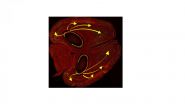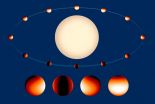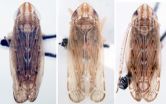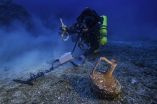Manipulating memory with light
2014-10-09
(Press-News.org) Just look into the light: not quite, but researchers at the UC Davis Center for Neuroscience and Department of Psychology have used light to erase specific memories in mice, and proved a basic theory of how different parts of the brain work together to retrieve episodic memories.
Optogenetics, pioneered by Karl Diesseroth at Stanford University, is a new technique for manipulating and studying nerve cells using light. The techniques of optogenetics are rapidly becoming the standard method for investigating brain function.
Kazumasa Tanaka, Brian Wiltgen and colleagues at UC Davis applied the technique to test a long-standing idea about memory retrieval. For about 40 years, Wiltgen said, neuroscientists have theorized that retrieving episodic memories -- memories about specific places and events -- involves coordinated activity between the cerebral cortex and the hippocampus, a small structure deep in the brain.
"The theory is that learning involves processing in the cortex, and the hippocampus reproduces this pattern of activity during retrieval, allowing you to re-experience the event," Wiltgen said. If the hippocampus is damaged, patients can lose decades of memories.
But this model has been difficult to test directly, until the arrival of optogenetics.
Wiltgen and Tanaka used mice genetically modified so that when nerve cells are activated, they both fluoresce green and express a protein that allows the cells to be switched off by light. They were therefore able both to follow exactly which nerve cells in the cortex and hippocampus were activated in learning and memory retrieval, and switch them off with light directed through a fiber-optic cable.
They trained the mice by placing them in a cage where they got a mild electric shock. Normally, mice placed in a new environment will nose around and explore. But when placed in a cage where they have previously received a shock, they freeze in place in a "fear response."
Tanaka and Wiltgen first showed that they could label the cells involved in learning and demonstrate that they were reactivated during memory recall. Then they were able to switch off the specific nerve cells in the hippocampus, and show that the mice lost their memories of the unpleasant event. They were also able to show that turning off other cells in the hippocampus did not affect retrieval of that memory, and to follow fibers from the hippocampus to specific cells in the cortex.
"The cortex can't do it alone, it needs input from the hippocampus," Wiltgen said. "This has been a fundamental assumption in our field for a long time and Kazu's data provides the first direct evidence that it is true."
They could also see how the specific cells in the cortex were connected to the amygdala, a structure in the brain that is involved in emotion and in generating the freezing response.
INFORMATION:
Co-authors are Aleksandr Pevzner, Anahita B. Hamidi, Yuki Nakazawa and Jalina Graham, all at the Center for Neuroscience. The work was funded by grants from the Whitehall Foundation, McKnight Foundation, Nakajima Foundation and the National Science Foundation.
[Attachments] See images for this press release:

ELSE PRESS RELEASES FROM THIS DATE:
2014-10-09
ANN ARBOR—An unexpectedly high amount of the climate-changing gas methane, the main component of natural gas, is escaping from the Four Corners region in the U.S. Southwest, according to a new study by the University of Michigan and NASA.
The researchers mapped satellite data to uncover the nation's largest methane signal seen from space. They measured levels of the gas emitted from all sources, and found more than half a teragram per year coming from the area where Arizona, New Mexico, Colorado and Utah meet. That's about as much methane as the entire coal, oil, ...
2014-10-09
An international research team comprised of German, Israeli and American ecologists, including Dr. Claus Holzapfel, Dept. of Biological Sciences, Rutgers University-Newark, has conducted unique long-term experiments in Israel to test predictions of climate change, and has concluded that plant communities in the Holy Land can cope with climate change of "biblical" dimensions. Their findings appear in the current issue of Nature Communications at http://www.nature.com/ncomms/2014/141006/ncomms6102/pdf/ncomms6102.pdf.
When taking global climate change into account, many ...
2014-10-09
A team of scientists using NASA's Hubble Space Telescope has made the most detailed global map yet of the glow from a turbulent planet outside our solar system, revealing its secrets of air temperatures and water vapor.
Hubble observations show the exoplanet, called WASP-43b, is no place to call home. It is a world of extremes, where seething winds howl at the speed of sound from a 3,000-degree-Fahrenheit "day" side, hot enough to melt steel, to a pitch-black "night" side with plunging temperatures below 1,000 degrees Fahrenheit.
Astronomers have mapped the temperatures ...
2014-10-09
Researchers at the Wyss Institute for Biologically Inspired Engineering at Harvard University have unveiled a new method to form tiny 3D metal nanoparticles in prescribed shapes and dimensions using DNA, Nature's building block, as a construction mold.
The ability to mold inorganic nanoparticles out of materials such as gold and silver in precisely designed 3D shapes is a significant breakthrough that has the potential to advance laser technology, microscopy, solar cells, electronics, environmental testing, disease detection and more.
"We built tiny foundries made ...
2014-10-09
MADISON, Wis. – In Wisconsin, bioenergy is for the birds. Really.
In a study published today in the journal PLOS ONE, University of Wisconsin-Madison and Wisconsin Department of Natural Resources (DNR) scientists examined whether corn and perennial grassland fields in southern Wisconsin could provide both biomass for bioenergy production and bountiful bird habitat.
The research team found that where there are grasslands, there are birds. Grass-and-wildflower-dominated fields supported more than three times as many bird species as cornfields, including 10 imperiled ...
2014-10-09
Three new species of leafhoppers from China in the genus Futasujinus were recently identified during a review of leafhoppers in museum collections in China, the UK, and Illinois. One of them, Futasujinus dietrichi, was "named after Dr. Chris Dietrich, University of Illinois, USA, in recognition of his good work on leafhoppers." The new species are described in an article in Annals of the Entomological Society of America.
The other two species are Futasujinus truncatus and Futasujinus hastatus. Both species epithets allude to processes on their aedeagal shafts.
All three ...
2014-10-09
Tempe, Ariz. (Oct. 9, 2014) - New Ebola research demonstrates that quick and forceful implementation of control interventions are necessary to control outbreaks and avoid far worse scenarios.
Researchers analyzed up-to-date epidemiological data of Ebola cases in Nigeria as of Oct. 1, 2014, in order to estimate the case fatality rate, proportion of health care workers infected, transmission progression and impact of control interventions on the size of the epidemic.
"Rapid and forceful control measures are necessary as is demonstrated by the Nigerian success story. This ...
2014-10-09
A Greek and international team of divers and archaeologists has retrieved stunning new finds from an ancient Greek ship that sank more than 2,000 years ago off the remote island of Antikythera. The rescued antiquities include tableware, ship components, and a giant bronze spear that would have belonged to a life-sized warrior statue.
The Antikythera wreck was first discovered in 1900 by sponge divers who were blown off course by a storm. They subsequently recovered a spectacular haul of ancient treasure including bronze and marble statues, jewellery, furniture, luxury ...
2014-10-09
WEST LAFAYETTE, Ind. – A new technique makes it possible to quickly detect the presence of drugs or to monitor certain medical conditions using only a single drop of blood or urine, representing a potential tool for clinicians and law enforcement.
The technique works by extracting minute quantities of target molecules contained in specimens of blood, urine or other biological fluids, and then testing the sample with a mass spectrometer.
Testing carried out with the technology takes minutes, whereas conventional laboratory methods take hours or days to yield results ...
2014-10-09
SAN FRANCISCO -- The information that interprets the genetic code in a new embryo differs depending on whether it comes from the father or mother, researchers at San Francisco State University have found.
The research, detailed in an article published today in the journal PLOS Genetics, sheds light on the multilayered process of how a sperm and egg pass along information needed for successful reproduction. Though one layer is the DNA code that is transferred, the new study identifies information not encoded by DNA, a so-called "epigenetic" layer of information that helps ...
LAST 30 PRESS RELEASES:
[Press-News.org] Manipulating memory with light




